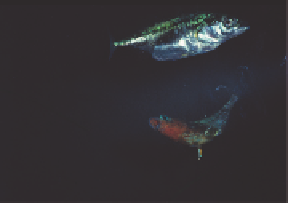Biology Reference
In-Depth Information
want a partner able to provide efficient parental care (heavily parasitized males may be
debilitated). The four key assumptions that need testing are: (i) parasites reduce host
fitness; (ii) parasite resistance is genetic; (iii) parasite resistance is signalled by the
elaboration of sexual ornaments; (iv) females prefer males with the most elaborate
signals. All four have been demonstrated in detailed studies of the three-spined
stickleback
Gasterosteus aculeatus
.
In the spring, male three-spined sticklebacks develop bright red colouration and build
nests. They then attempt to attract gravid females by displaying with a zig-zag dance
(Fig. 7.12a). If a female is attracted, she enters the nest to lay her eggs and the male
immediately follows her, fertilizing the eggs externally. The male then cares for the eggs
and young fry for a period of about 10 days. Manfred Milinski and Theo Bakker (1990)
showed, by a clever experiment, that females preferred to mate with males with more
intense red colouration. When given a choice between two males with nests in a
laboratory tank, the females preferred the redder male under normal white light
condition, but under green light (where the red colour was not visible) the females
showed no strong preference (Fig. 7.12b). The males courtship display was unaffected
by the lighting conditions, so this experiment showed neatly that it was the male red
colouration that influenced female choice.
Why do females prefer redder males? Milinski and Bakker showed that a male's red
colouration signalled his physical condition (redder males had greater mass per unit
length). When the preferred bright males were infected with a parasite, both their
condition and their red intensity declined. Under white light females now no longer
preferred them, while under green light the males' parasitization had no effect on
female choice.
Female
sticklebacks prefer
redder males,
who are in better
condition …
(a)
(b)
300
300
250
250
200
200
150
150
100
100
50
50
white light
green light
0
0
0
0.5
1
1.5
0
0.5
1
1.5
Colour intensity (brighter-duller male)
Fig. 7.12
(a) Male three-spined stickleback in breeding colouration zig-zagging around a gravid female. Photo
© Manfred Milinski. (b) Under white light (left graph) females prefer the brighter of two males. The experiment
was done with 15 pairs of males and plots their difference in red intensity against the strength of the female
preference for the brighter male. The greater the difference in red intensity, the stronger the preference for
the brighter male. Under green light (where females are unable to distinguish differences in red) there is no
significant preference (right graph). From Milinski and Bakker (1990). Reprinted with permission from the Nature
Publishing Group.










































































